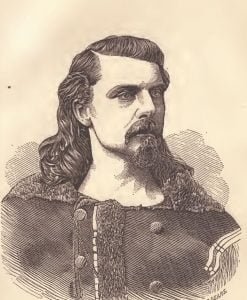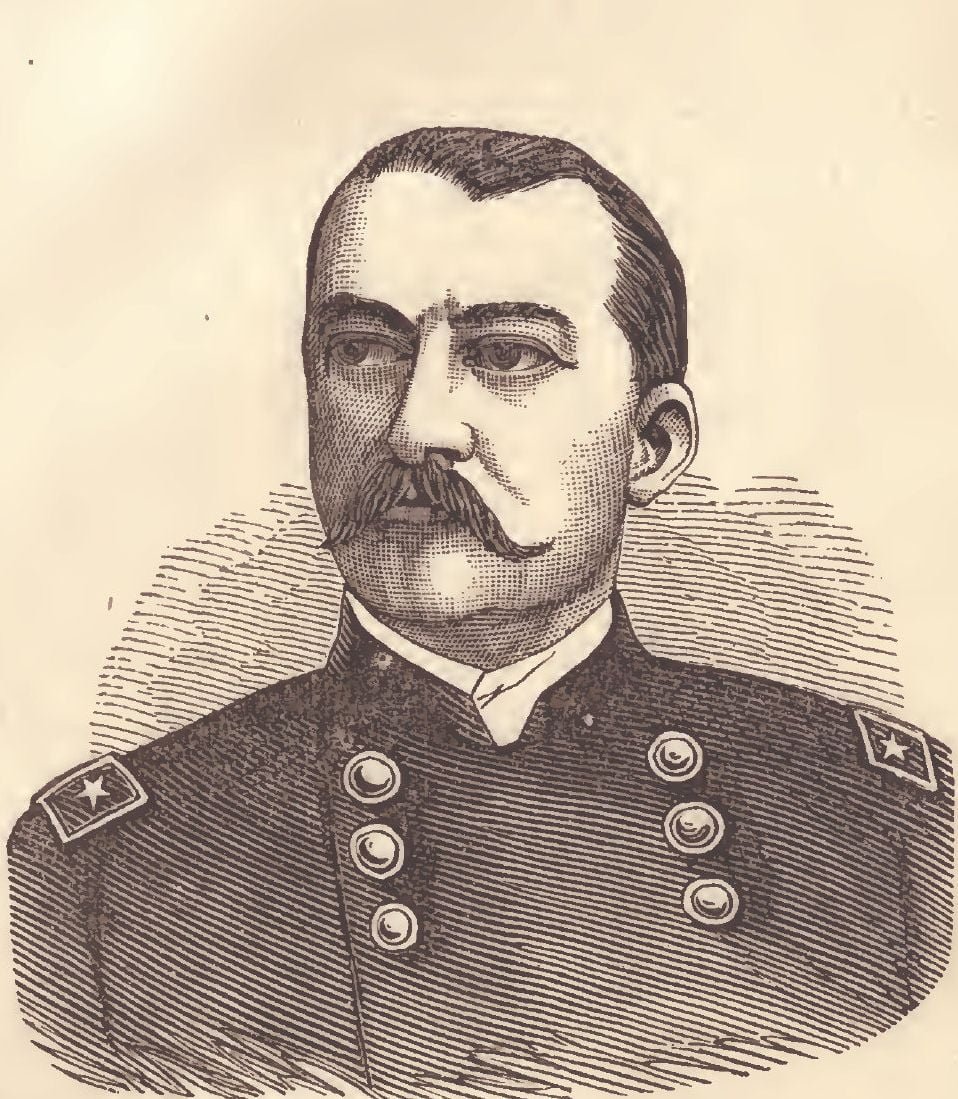One of the best known, and since the death of the renowned Kit Carson, probably the most reliable guide on the Western frontier, is William Cody, otherwise known as “Buffalo Bill.” His exploits have been the theme of a dozen novelists, and in the year just past (1870-72) his movements have been as accurately and frequently chronicled by the daily press throughout the country as they would have been had he been an official magnate of the highest degree. There is something especially attractive in the romance attending the career of one of these noted hunters, which never palls upon the reader. The picturesque surroundings, the distance from us of their scene of action, the wild, nomadic life of the frontiersmen, all have their charms.
Of all the hunters now in the service of the United States, either on the Atlantic or Pacific Slope, or to the southward, Buffalo Bill has attained the most permanent celebrity.

Of his boyhood but little is known, save that he was of Western birth and that his parents were of the humble class and were much respected in the sparsely settled district where “William” was born, and where for many years they resided. When quite young like Carson he imbibed a fondness for the life of adventure, which the profession of a hunter and trapper opened out, and finally he started out on his “own hook,” rifle in hand, to seek his own livelihood. For a few years nothing of importance marked his career. He, of course, underwent the usual perils and dangers which beset those who day after day permeate the trackless forests.
During the later troubles with the Indians, Cody became famous among the Indians, and by his honesty of purpose, his strict adherence to his word, won their admiration of his character as much as by his prowess in his numerous contests, or “shootin’ matches,” as he termed his encounters with them, he made them fear him.
As a marksman he probably has no rival upon the plains, and as for blunt, straightforward and sometimes rough expression of his opinions, he is a sort of ‘f Old Hickory “in hunting costume. Among the Comanche, the Arapaho, and the Cheyennes, with whom in time of peace he has frequently hunted, and who, in conflict, have tested his skill, he is regarded as a great warrior.
Innumerable anecdotes are related of his prowess, and the stories of his hair breath escapes and dangerous adventures while hunting and trapping stories which have formed the warp and woof of the exaggerations of the dime novelists would fill a volume even larger than this.
On one occasion in the earlier part of his career, while tramping the woods upon the upper Arkansas in search of game, he struck upon an Indian trail, which led northward. Closely examining it, he discovered by that knowledge which the experienced hunter only possesses that it had been made by a party of Sioux, with whom, at that time the Government had had serious trouble, and who evidently had been to some of the lower settlements upon one of their murderous forays. He followed it that day at night camping under shelter of an old Sycamore which had been riven by lightning. In the afternoon of the succeeding day, near nightfall, he came within sight of the party. They were three warriors, and they had halted in a little opening in the forest, besides a little stream or rivulet. They were evidently not anticipating pursuit. They were seated upon the trunk of a fallen tree, resting. Cody took in the situation at a glance. He crept up as close as possible, and finally managed to get near enough, behind a cluster of alder bushes to hear them converse. Presently they arose and two of them started off in an opposite direction, leaving the third behind to await their return. He moved about carelessly, yet still keeping a vigilant look out. Nearer crept Cody, and presently with a terrible leap, but as noiseless as a panther, the hunter sprang upon the warrior, and before the astonished red man could realize the position, he was hurled to the ground with Cody’s knee upon his breast and his hand upon his throat.
Stalwart and strong as the warrior was, one glance at Cody‘s face was sufficient. He knew him too well, and he knew that if he kept silent and made no resistance his life was safe, and his chance of getting the better of his antagonist by some cunning trick would be materially improved. He saw the gleaming knife of the trapper, and had no desire to feel its edge. Quickly almost as thought Cody bound his captive with thongs, hand and foot, and then, in order to secure silence, unloosed one of the Indian’s moccasins, and crammed it in his throat, thus effectually gagging him. He then half carried and half dragged him from the clearing to the bushes, where he himself had been concealed, and there awaited results. In half an hour the two absentees returned, and were intensely astonished to find their companion gone. As Cody had anticipated, one of them began examining the ground, while the other went into the forest again. The warrior left behind soon discovered the traces of the recent brief struggle, and following up his discovery, approached the hiding place of the foe.
Coolly, Cody awaited his coming, and when a moment after the Sioux raised his head to peer into the bushes, Cody was upon him, and served him the same trick he had upon the other. But the warrior made a desperate effort to free himself, and the noise of the struggle brought the remaining warrior to the scene. This did not daunt Cody. All he cared for was to prevent the still un-captured warrior from using his rifle.
The warrior with whom he had grappled had never seen Cody before this. The remaining Indian rushed upon the hunter. A quick movement of his arm, a flash, a death yell, and the revolver did its work upon the hunter’s opponent, and left him alone in his contest with the one beneath him. It was of brief duration. The iron muscle of the white man prevailed, and in a few seconds more the warrior lay bound and helpless beside his companion. Now comes the most wonderful part of the adventure. By threats and by an ingenious method of tying them side by side together, so that while they could walk they were other-wise entirely at his mercy, he drove the two before him sixty miles and brought them captives into the camp with which he was then connected.
There are other and not so bloodless adventures in which he was the chief actor we could relate had we the space.

In 1871-72, “Buffalo Bill” was especially honored by an appointment upon the hunting staff of General Sheridan upon the occasion of the visit of the Grand Duke Alexis to the hunting grounds of the West. It was the especial desire of the Royal guest to have a little experience in the excitement of a “Buffalo raid,” and accordingly the most renowned of living hunters and trappers, Cody, was at once selected by General Sheridan to superintend the preparations. The “grand hunt” was an entire success, and Duke Alexis, with a portion of his suite, accompanied, as his especial tutor in the art of Buffalo slaughter, by “Buffalo Bill” and by General Sheridan and other officers of the army, with several distinguished civilians had a four or five days’ experience, which they will doubtless long remember. The Grand Duke was so well pleased with Cody‘s skill and daring and with his modesty of deportment that he made him a valuable present of which he is extremely proud.
In several important expeditions sent out by the Government Cody has been the chosen guide and hunter, and in every instance he has received not only the formal thanks of the department, but the warmest acknowledgments of the officials accompanying him. Strictly temperate in his habits, quiet and somewhat reserved in his social disposition, he bids fair to live to good age and earn for himself a fame as enduring as that of his Compeer Carson in the annals of our border history. During the year 1871 he visited the eastern seaboard cities, and everywhere received a cordial welcome, being feasted and honored to a much greater extent than he desired. Upon several occasions he peremptorily declined not only the public acknowledgments tendered him, but entirely ignored the private hospitalities offered so profusely. Upon his return he bore with him what he termed “a camp full” of valuable presents, of which the most prized were a couple of splendid rifles and a case of handsome silver-mounted revolvers.
Should the Indian difficulties again assume a serious aspect it will be hard to estimate the greatness and extent of the services such a man as William Cody will beyond doubt render the country which chums him as one of her most famous sons.
